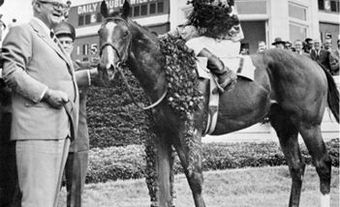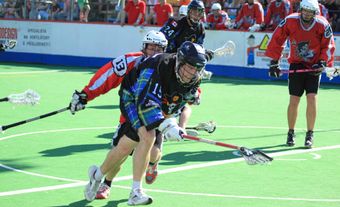Thoroughbred Racing
Thoroughbred racing is the racing of a special breed of horse over courses that, in North America, range from less than 1 mile to 1.5 miles in length (1.6-2.4 km). In Canada and the United States, flat races on grass or dirt are the rule. In Europe, both flat and steeplechase races (in which the horse and rider are also required to clear a number of obstacles, such as hedges) are carried out. All thoroughbred horses are descended from the Arabian, Turkish and Barbary horses imported into England in the 1600s. In fact, most thoroughbreds trace their lineage to one of 3 horses - Byerly Turk, the Godolphin Arabian and the Darley Arabian.
On the one hand, horse racing is viewed as a sport of the wealthy, based on the traditions of a long and valued history. On the other hand, it has its shady side, associated with gambling and complemented by the rich subculture of its citizens on the back stretch. From its earliest days in Canada, thoroughbred racing has reflected this dichotomy. There is ample evidence that it has always been a popular sport, particularly in a pioneer society where the horse was a vital means of transportation. Still, in 1771 horse racing was banned by Halifax authorities because they believed it turned the local citizenry into idle, immoral gamblers. Nevertheless, in 1825 the Halifax Turf Club was formed and held its first meeting.
Ownership of a horse - even at the expense of economic hardship - was a potent status symbol among French Canadians, and horse racing enjoyed great popularity in Lower Canada [Québec] in the late 18th and 19th centuries - to the extent that sporting reports in newspapers of the time show a concentration on racing equal to that of almost all other sports combined. The Québec Turf Club was formed in 1789, and in 1836 the King's Plate, a race for a purse of 100 guineas, was first held in Trois-Rivières. Initially, it was restricted to horses bred in Lower Canada, but in 1859 horses from Upper Canada were admitted. The next year the Queen's Plate was held in Toronto for the first time; it has been run every year since then, making it the oldest continuing stakes race in North America - 15 years older than the Kentucky Derby. The winner of that 1860 race was a horse named Don Juan, owned by the James White Stable of Bronte and Milton, Ont. Small breeders with limited means could hope to win the race at that time. This was also a period when the quality of the horses was questionable and the practices of many owners suspect. In 1865 the judges disqualified 3 horses before declaring a winner of the Queen's Plate. Ten years later, the winner of Canada's most prestigious race was a previously unsuccessful 8-year-old named Trumpeter.
In August 1881 Colonel Casimir Gzowski held a meeting in Toronto with some of that city's most respected citizens to form the Ontario Jockey Club in order "to lift horse racing out of the mire." As the club's first chairman, Gzowski sought to bring the sport to respectability by ridding it of its bad reputation and improving the quality of Canadian thoroughbreds. A major step toward these aims occurred 2 years later when the club was successful in getting the Governor General, the Marquess of Lorne, and his wife, Princess Louise, 4th daughter of Queen Victoria, to attend the Queen's Plate. Not only did this result in the race being held permanently in Toronto, it also helped attract the interest of the richer classes of Canadian society. In 1891 a horse named Terror Colt, owned by Joseph Seagram, a wealthy distiller from Waterloo, Ont, won the first of 20 Queen's Plate victories for the Seagram Stables. The era of the wealthy owner was established.
The sport has also been sustained by the 2-dollar bettor, whose interest over the years helped ensure that racing would continue to draw a large share of space in the print media. At the turn of the century, the activities of bookmakers were enough to scare away even the most courageous of patrons. Odds were shortened in their favour; they ran their horses under others' names and fixed races. Finally, in 1910, the Canadian Parliament, by one vote, banned bookmakers. Next year, the establishment of pari-mutuel betting at tracks in Toronto, Winnipeg and Calgary brought more honesty to betting and helped save the sport.
The sport got an important boost in Canada's West from R.L. "Jim" Speers, a feed and grain entrepreneur who had moved from Toronto to Winnipeg and ultimately became the dean of the sport there. In 1922 he bought his first racetrack, and by 1925 owned 3 more. He eventually came to control tracks or meetings in Winnipeg, Regina, Saskatoon, Calgary and Edmonton. Realizing the difficulty in obtaining quality horses that would provide attractive racing meetings, he set up his own breeding farm in Winnipeg, which by the mid-1930s had become the country's largest.
The great economic difficulties experienced throughout Canada in the 1930s affected race-track operations, heightening many of the abuses associated with the sport. Through the efforts of governments and racing operators, however, a cleanup was accomplished by the late 1940s. The sport was evolving into a business, and one of the main forces behind this transformation was E.P. Taylor. Taylor was responsible for making horse racing more efficient by closing down several old, unprofitable tracks and using their charters to organize racing days at the rebuilt Fort Erie track and Woodbine, a large new facility in northwest Toronto. The longer racing seasons that resulted saw greater attendance, higher purses and better horses. Taylor had also, in 1949, bought Parkwood Stables from R.S. McLaughlin, the Canadian automobile pioneer and one of the top racehorse breeders in the 1930s and 1940s. Renamed the National Stud Farm, it produced 15 Queen's Plate winners, including the legendary Northern Dancer. The result of a long-term breeding plan instituted by Taylor, this chunky little horse displayed a tremendous will to win, and in 1964 became the first Canadian-bred horse to win the Kentucky Derby. He also won the Preakness, thus taking 2 jewels in the American triple crown. Retired to stud by a leg injury that same year, his winnings in purses totalled $580 000. In his second year at stud, he sired the magnificent Nijinsky, which had a brilliant career in Europe, winning the Epsom Derby, Irish Derby and other major-stakes races. Another of his progeny, The Minstrel, won $2 million in prizes in 1977. It has been said that Northern Dancer influenced the bloodlines of all top North American thoroughbreds.
In 1973 New Brunswick's Ron Turcotte rode Secretariat to victory in the American triple crown. Turcotte's career ended 5 years later in a spill that left him paralyzed from the waist down, but not before he had established himself as one of North America's best jockeys. That year also saw Sandy Hawley, of Mississauga, Ont, ride 515 winners, becoming the first jockey to surpass the 500 mark in one year. Ten years later Sunny's Halo won the Kentucky Derby and in 1991 Dance Smartly won the Breeders Cup Distaff, the first Canadian bred horse to win a Breeders Cup race. By September 1980, Hawley, at the age of 31, had ridden his 4 000th career winner, becoming one of only 10 men to reach that goal, and in 1992 became the 8th to ride 6 000 winners. Jeffery Fell, with more than 2 600 career wins, was another distinguished rider until he retired in 1986. Earlier, Johnny Longden rode 6 032 winners between 1927 and 1966. His contemporary, George Woolf, was known as "the Iceman" because of his coolness in the saddle. He rode many majorstakes winners, including Seabiscuit during his great victory over War Admiral in a 1938 match race. Woolf was killed in 1946 in a racing accident. Another top jockey of that era was Newfoundland's Nick Wall, who rode Stagehand to win the 1938 Santa Anita Derby. Avelino Gomez, rider of 4 078 winners, led all North American jockeys in victories in 1966. He was killed in an accident at Woodbine during the Canadian Oaks race in June 1980.
Women have recently done well in Canadian thoroughbred racing: in 2006 Josie Carroll became the first female trainer to train a winning horse in the Queen's Plate and in 2007 Emma-Jayne Wilson became the first-ever female jockey to win the race.
Woolf, Longden, Hawley, Turcotte and Gomez have been honoured by the US Racing Hall of Fame. The Canadian Horse Racing Hall of Fame, located in Toronto, honours jockeys, horses and those who have made significant contributions to Canadian horse racing. Woodbine Racetrack in Toronto is currently Canada's premier track, and the $2-million Pattison Canadian International is currently the richest purse in the country.

 Share on Facebook
Share on Facebook Share on X
Share on X Share by Email
Share by Email Share on Google Classroom
Share on Google Classroom





